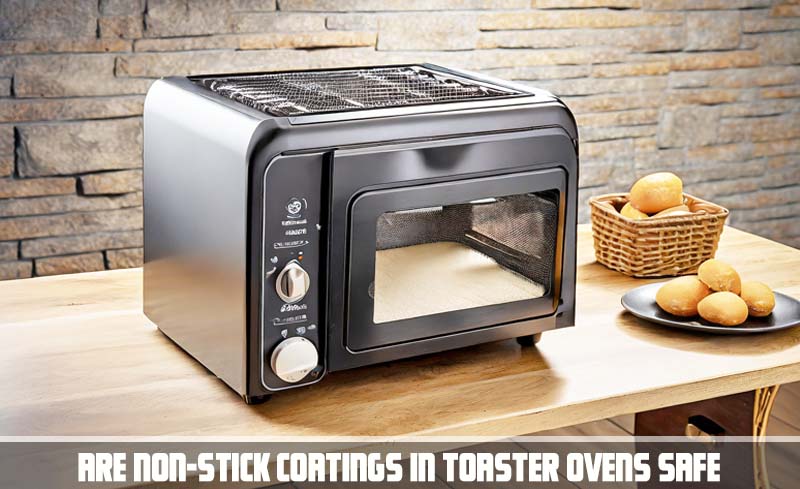As a curator of kitchenusers, I’ve had the privilege of delving into the world of culinary creations alongside countless passionate home chefs. I’ve always been drawn to the convenience and versatility of toaster ovens. They’re perfect for quick meals, reheating leftovers, and even baking small batches of treats. But one question that often arises is whether the non-stick coatings used in toaster ovens are safe for our health.
I have spent a lot of time researching and testing various kitchen accessories, including the toaster oven. That’s why, I can confidently say that non-stick coatings in toaster ovens, when used properly, are generally safe. However, there are some precautions we should take to ensure we’re not exposing ourselves to any potential health risks.
In this blog post, I’ll delve into the world of non-stick coatings, explore their safety concerns, and provide practical tips for using your toaster oven safely and effectively. Whether you’re a seasoned cook or just starting out, this guide will help you make informed decisions about your toaster ovens and enjoy your culinary creations with peace of mind.
Are Non-Stick Coatings in Toaster Ovens Safe?
Non-stick coatings have become a staple in modern kitchens, gracing the interiors of pots, pans, and even toaster ovens. These coatings, typically composed of polytetrafluoroethylene (PTFE), commonly known as Teflon, offer a slick surface that prevents food from sticking, making cooking and cleaning a breeze.
However, concerns have arisen regarding the safety of non-stick coatings, particularly when exposed to high temperatures like those reached inside toaster ovens. Studies have shown that PTFE can break down at temperatures exceeding 570°F (300°C), potentially releasing harmful fumes containing fluorinated compounds.
Potential Health Risks
Fluorinated compounds, such as perfluorooctanoic acid (PFOA) and Perfluorooctanesulfonic acid (PFOS), have been linked to a range of health concerns, including:
- Immune system suppression
- Cancer development: here, you can read full details about ‘Do Toaster Ovens Cause Cancer?‘
- Endocrine disruption
- Reproductive problems
These concerns have prompted some manufacturers to switch to alternative non-stick coatings, such as ceramic or silicone, which are considered safer at high temperatures.
Minimizing Risks
While the long-term health effects of non-stick coatings remain a subject of ongoing research, there are steps you can take to minimize potential risks:
- Choose PFOA-free coatings: Look for toaster ovens that specifically state they are PFOA-free.
- Avoid overheating: Preheat your toaster oven to the recommended temperature and avoid using excessively high temperatures.
- Ventilate your kitchen: Ensure adequate ventilation while using your toaster oven to minimize exposure to fumes.
- Clean regularly: Hand-wash your toaster oven with mild soap and water to remove food particles and prevent buildup.
- Replace damaged coatings: If your toaster oven’s coating is chipped, scratched, or peeling, consider replacing it with a new one.
Alternatives to Non-Stick Coatings
If you’re concerned about the potential risks of non-stick coatings, there are Alternatives to Non-Stick Coatings available:
- Enameled coatings: Enamel coatings are durable and heat-resistant, offering a nonstick surface without the use of PTFE.
- Stainless steel: Stainless steel interiors are easy to clean and don’t require a non-stick coating.
- Cast iron: Cast iron is a versatile and long-lasting material that can be seasoned to create a nonstick surface.
NOTE: Non-stick coatings in toaster ovens are generally safe when used properly. However, it is important to be aware of the potential health risks and take precautions to minimize exposure.
How to Identify various forms of non-stick coating in Toaster Oven.
Identifying the type of non-stick coating in your toaster oven can be tricky, as manufacturers often use proprietary formulas and don’t always disclose the exact composition. However, there are some general guidelines you can follow:
- Look for specific labeling: Some manufacturers may label their toaster ovens as “PFOA-free” or “PTFE-free,” indicating the absence of these potentially harmful chemicals.
- Visually inspect the coating: PTFE coatings typically have a smooth, slightly glossy appearance, while ceramic coatings often have a more matte finish.
- Perform a water test: Drip a few drops of water onto the coating. If the water beads up and forms droplets, it’s likely a PTFE coating. If the water spreads out and wets the surface, it’s more likely a ceramic coating.
Here’s a table summarizing the key characteristics of different non-stick coatings:
| Coating | Appearance | Heat Resistance | Safety Concerns |
|---|---|---|---|
| PTFE (Teflon) | Smooth, glossy | Up to 570°F (300°C) | Potential PFOA and PFOS release |
| Ceramic | Matte, textured | Up to 750°F (400°C) | Generally considered safe |
| Enamel | Glassy, hard | Up to 500°F (260°C) | Generally considered safe |
| Stainless steel | Metallic | Very high | No non-stick properties |
| Cast iron | Dark, textured | Very high | Requires seasoning for non-stick properties |
Remember, if you have any concerns about the safety of the non-stick coating in your toaster oven, it’s always best to err on the side of caution and replace it with a toaster oven that uses a safer alternative.
How do you avoid nonstick toaster oven coatings?

Avoiding non-stick toaster oven coatings is a simple and effective way to minimize potential health risks. Here are some tips for choosing a non-stick-free toaster oven:
- Look for stainless steel interiors: Stainless steel is a durable, easy-to-clean material that doesn’t require a non-stick coating.
- Choose enameled coatings: Enamel coatings are heat-resistant and offer a nonstick surface without the use of PTFE.
- Consider cast iron: Cast iron is a versatile and long-lasting material that can be seasoned to create a nonstick surface.
- Check for PFOA-free or PTFE-free labels: Some manufacturers may label their toaster ovens as “PFOA-free” or “PTFE-free,” indicating the absence of these potentially harmful chemicals.
- Contact the manufacturer: If you’re still unsure about the type of coating used in a particular toaster oven, you can always contact the manufacturer for more information.
Chemicals of Concern in Toaster Ovens
Toaster ovens can vary in terms of materials used and potential chemicals present. Some potential chemicals of concern in toaster ovens or related appliances might include:
| Chemical of Concern | Potential Health Effects |
|---|---|
| PFAS (Per- and polyfluoroalkyl substances) | Cancer, reproductive problems, immune system suppression |
| Flame retardants | Hormonal disruption, neurodevelopmental problems |
| Non-stick ceramic coatings | Potential for leaching into food, unknown long-term health effects |
| Aluminum | Neurological problems, Alzheimer’s disease |
| Prop 65 chemicals of concern (lead, cadmium, bisphenol A) | Cancer, birth defects, reproductive problems |
How to Choose a Non-Toxic Toaster Oven?
Choosing a non-toxic toaster oven involves considering various factors, including the materials used, the coating type, and the overall safety features. Here’s a comprehensive guide to help you make an informed decision:
1. Material of the Interior:
- Stainless steel: Stainless steel is a durable, non-toxic material that doesn’t require a non-stick coating. It’s easy to clean and doesn’t release any harmful chemicals when heated.
- Enameled coating: Enamel is a glass-like coating that is heat-resistant and nonstick. It’s considered safe for high-heat cooking and doesn’t leach harmful chemicals into food.
- Cast iron: Cast iron is a versatile and durable material that can be seasoned to create a nonstick surface. It’s safe for high-heat cooking and doesn’t release harmful chemicals.
2. Coating Type:
- Avoid PTFE (Teflon) coatings: PTFE, commonly known as Teflon, is a non-stick coating that can release harmful fumes when heated to high temperatures. Opt for toaster ovens without PTFE coatings.
- Consider ceramic coatings: Ceramic coatings are a safer alternative to PTFE coatings. They are generally considered non-toxic and can withstand high temperatures without releasing harmful chemicals.
- Check for PFOA-free labels: PFOA is a chemical used in the manufacturing of some non-stick coatings. It’s linked to health concerns, so look for toaster ovens labeled “PFOA-free” or “PTFE-free.”
3. Safety Features:
- Automatic shut-off: An automatic shut-off feature prevents the toaster oven from overheating, reducing the risk of fire hazards.
- Cool-touch exterior: A cool-touch exterior prevents burns from accidentally touching the hot surface of the toaster oven.
- Non-slip feet: Non-slip feet ensure the toaster oven stays stable and doesn’t tip over, preventing accidents.
4. Additional Considerations:
- Size and capacity: Choose a toaster oven that fits your needs in terms of size and capacity. Consider the amount of food you typically cook and the available space in your kitchen.
- Cooking functions: Some toaster ovens offer a variety of cooking functions, such as broiling, roasting, and baking. Consider the features that are important to you and your cooking style.
- Brand reputation: Choose a toaster oven from a reputable brand known for its quality and safety standards. Read reviews and compare different brands before making a decision.
By considering these factors, you can make an informed choice and select a non-toxic toaster oven that is safe, durable, and meets your culinary needs.
Few Things to Keep in Mind When Looking for Toaster Ovens Without Nonstick
Here are a few things to keep in mind when looking for toaster ovens without nonstick:
1. Material
- Stainless Steel: This is a great option for a toaster oven without nonstick. It is durable, easy to clean, and does not contain any harmful chemicals.
- Enamel: This is another good option for a toaster oven without nonstick. It is heat-resistant and nonstick, and it does not release any harmful chemicals.
- Cast Iron: This is a versatile option for a toaster oven without nonstick. It can be seasoned to create a nonstick surface, and it is very durable.
2. Coating
- Avoid PTFE (Teflon): This is a type of nonstick coating that can release harmful fumes when heated to high temperatures.
- Ceramic: This is a safer alternative to PTFE. It is generally considered non-toxic, and it can withstand high temperatures without releasing harmful chemicals.
- PFOA-free: This means that the toaster oven does not contain PFOA, a chemical that is linked to health concerns.
3. Safety Features
- Automatic shut-off: This will prevent the toaster oven from overheating.
- Cool-touch exterior: This will prevent you from burning yourself when you touch the toaster oven.
- Non-slip feet: This will help to prevent the toaster oven from tipping over.
4. Size and Capacity
- Consider the amount of food you typically cook.
- Make sure the toaster oven will fit in your kitchen.
5. Cooking Functions
- Some toaster ovens offer a variety of cooking functions, such as broiling, roasting, and baking.
- Consider the features that are important to you and your cooking style.
6. Brand Reputation
- Choose a toaster oven from a reputable brand known for its quality and safety standards.
- Read reviews and compare different brands before making a decision.
By following these tips, you can find a toaster oven without nonstick that is safe, durable, and meets your needs.
What is safe to put in a toaster oven?

Toaster ovens are versatile appliances, but it’s essential to use them safely to avoid potential hazards. Here are some common items and foods that are generally safe to put in a toaster oven:
Safe materials to put in a toaster oven:
- Stainless steel: Stainless steel is a durable and heat-resistant material that is safe for high-temperature cooking. It is also easy to clean and does not release any harmful chemicals.
- Cast iron: Cast iron is another durable and heat-resistant material that is safe for high-temperature cooking. It can be seasoned to create a nonstick surface, and it is also very versatile.
- Enamel: Enamel is a smooth, glassy coating that is heat-resistant and nonstick. It is also safe for high-temperature cooking and does not release any harmful chemicals.
- Oven-safe glass or ceramic bakeware: Oven-safe glass or ceramic bakeware is safe for use in a toaster oven, as long as it is not cracked or chipped.
- Aluminum foil: Aluminum foil can be used to line the bottom of a toaster oven to catch spills and make cleanup easier. However, it should not be used to touch the heating elements.
- Parchment paper: Parchment paper is another safe option for lining the bottom of a toaster oven. It is heat-resistant up to 450 degrees Fahrenheit.
Foods that are safe to put in a toaster oven:
- Bread: Bread is a classic toaster oven food. It can be toasted for breakfast, sandwiches, or snacks.
- Pastries: Pastries like croissants, muffins, and Danishes can be heated in a toaster oven to make them crispy and warm.
- Pizza: Pizza can be reheated in a toaster oven to get a crispy crust and melty cheese.
- Vegetables: Vegetables can be roasted in a toaster oven to bring out their sweetness and flavor.
- Chicken: Chicken can be cooked in a toaster oven to make a quick and easy meal.
- Fish: Fish can also be cooked in a toaster oven. It is a healthy and flavorful option.
Conclusion
My personal experiences, coupled with extensive research into the matter, have led me to conclude that non-stick coatings in toaster ovens, particularly those containing PTFE, should be approached with caution. While they offer convenience, the potential health risks associated with overheating these coatings warrant careful consideration.
To minimize potential risks, I recommend following the above guidelines and opting for safer alternatives. You can make informed decisions about using non-stick toaster ovens and safeguard your culinary adventures. Remember, a well-informed and cautious approach to kitchen appliances is essential for a healthy and enjoyable cooking experience.
Please leave a comment below with your thoughts, tips, or suggestions. Don’t forget to share this article with your friends and family who might also be concerned about the safety of their toaster oven. Thank You!

Tammy E. Edison is a distinguished specialist in the world of kitchen appliances, and she is proud to be a part of the dynamic team at kitchenusers.com. With a background in engineering and a passion for culinary innovation, Tammy E. Edison has established herself as a go-to expert for all things related to kitchen appliances technology.


